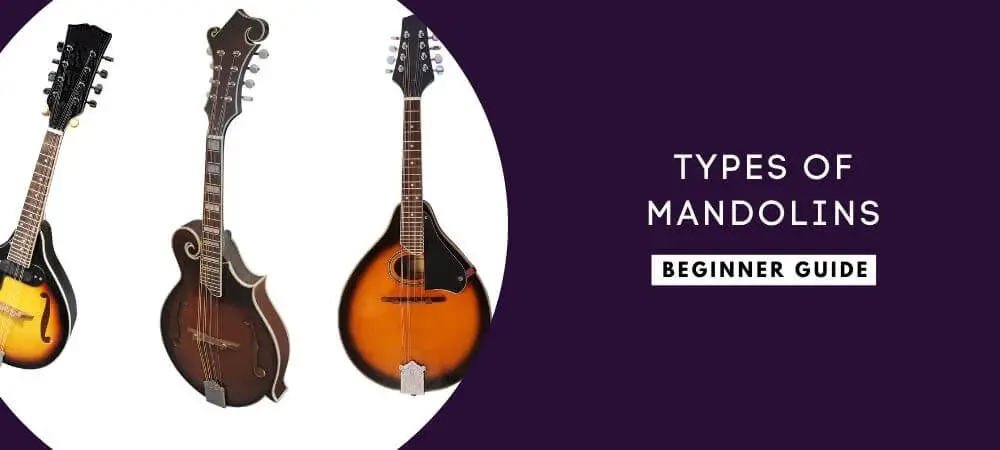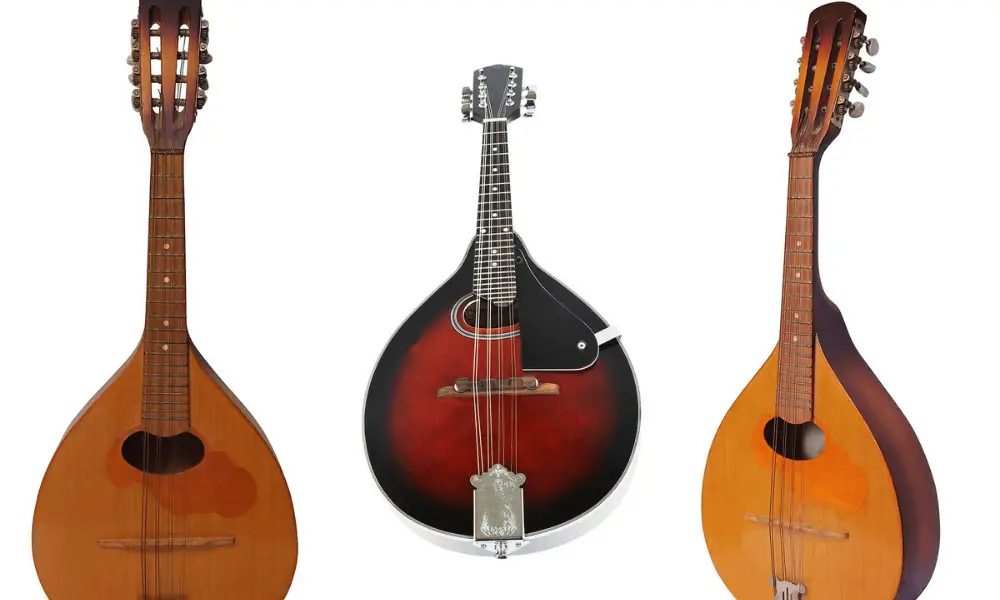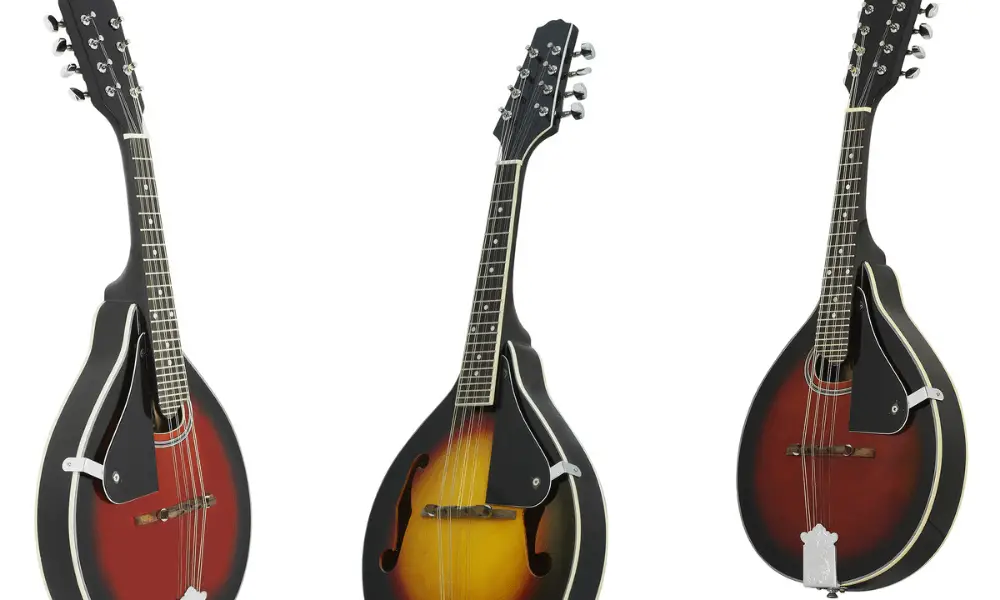Mandolins have a long and rich history, spanning all the way from the middle ages to the modern mandolins of today.
As such, there are many different types of mandolin styles, all the way from bluegrass mandolins to classical mandolins.
Just how much do you know about this tiny instrument?
Well, let’s see.
Table of Contents
The Main Types Of Mandolins
Bowl back Mandolins
This mandolin style goes by various other names, including Neapolitan mandolin, Classical mandolin, or round-backed mandolin. Perhaps you might even have heard it being referred to as Classical bowl back mandolins. (these are also usually the mandolins recommended for beginners)
Just as the name suggests, the bowl back mandolin has a deep bottom that uses curved strips of wood glued together to achieve the bowl shape.
The instrument was most commonly manufactured in Europe, and it was also a pretty popular design among Japanese luthiers.
The European model typically had a scale length of 13-inch (330mm).
Neapolitan mandolins usually have a bent soundboard, which is the top part of the instrument. In addition to being bent, the roundtable is also canted in two planes, and this is done to ensure that the design can withstand the tension of the 8 steel strings.
Then the hardwood fingerboard either sits on top of or is designed to be flush with the soundboard.
Initially, the older classical mandolin used wooden tuning pegs, but this has been replaced with metal tuners operated by a gear on newer instruments.
The movable bridge is made of hardwood, and there is a pickguard glued below the soundhole to protect the rounded bowl from damage by the plectrum.
This mandolin style produced round deeper tones and was used to play traditional world music such as renaissance, baroque and classical music.
The bowl-back mandolin isn’t very popular nowadays, and for that reason, they are both pretty rare and pretty expensive.
Archtop Mandolins
You may also know this mandolin style as the carved-top mandolin, Bluegrass mandolin, or American mandolins.
It derives its name from the arched tops and the similarly arched backs, customarily carved out of solid wood.
The arched-style mandolin cropped up in the USA at the end of the 19th century, and this design is credited to Orville Gibson.
As the design came to be called, the Gibson mandolins evolved into two styles, namely the F style mandolin and the A-style mandolin.
F-Style Mandolins
The Florentine, or F style mandolin for short, is best identified by the decorative scroll located near the neck of the musical instrument and the two points on the lower part of the body.
The scroll feature brings about some added weight, and because of this, the instrument has internal bracing to support the top.
The soundhole on F style models is in the form of a calligraphic f. These f shaped holes are also known as the f-hole, and each mandolin comes with two f-holes.
F style mandolins are more expensive than A-style mandolins because their intricate design is time-consuming and requires complicated woodwork.
A-Style Mandolins
The A-style mandolin is shaped like a pear or a teardrop rather. This bluegrass mandolin has a simple design and is plainer in appearance, lacking the points and scrolls you would find on F style mandolins.
The A-style models come with oval sound holes located directly under the strings.
Arched top mandolins, both F style and A style, are best suited for American folk music and bluegrass music.
However, you will rarely see bluegrass mandolin players playing an A style model because they prefer the f style instrument. The A-style mandolins are more suited to folk, Irish and Celtic music.
Flatback Mandolins
The flat-backed mandolin was first developed in Europe in the 1850s.
The style uses a thin sheet of wood for the instrument’s back, and similar to a guitar, this sheet is braced. This back bracing is done to protect the belly from damage while playing.
This style features a round soundhole, while the body is a rounded almond shape with a flat soundboard.
Depending on the designer, there are times when the soundboard could be canted instead of lying flat.
Flat-backed mandolins are best suited for British, Irish, and Brazilian folk music.
Other Types Of Mandolins
The huge mandolin family encompasses different mandolin types, whereby the instruments differ in scale length and tuning.
Typically, shorter scale lengths are easy to master when playing tunes, while a longer scale length is better for chord work and accompaniment. The sweet spot would be the ideal scale length that can do both, which is just what you get with the mandolin.
The standard mandolin is a pluck string instrument tuned G-D-A-E similar to violin tuning, and with the double strings tuned in unison. It is the soprano member of the mandolin family and has a typical scale length of about 13 inches (330mm).
Now that that’s covered, let’s take a look at the other mandolin variations.
Piccolo
The piccolo is a rare member of the mandolin family, and its typical scale length is about 9.5 inches (240mm).
A piccolo’s standard tuning is an octave above the tenor mandola and one-fourth above the mandolin.
The tone of the piccolo makes it ideal for use in mandolin orchestras or for mandolin musicians who are looking for a dedicated harmony instrument for mandolin duets.
Mandola
In Europe, the mandola is popularly referred to as the tenor mandola. The instrument has the same tuning as a viola, C-G-D-A, and its typical scale length is about 16.5 inches (420mm).
The tenor mandola is tuned a fifth lower than the mandolin, and its fretboard is two frets longer than the mandolin.
Octave Mandolin
The octave mandolin, also known as the Octave mandola, is tuned G-D-A-E, a full octave below the mandolin.
The typical scale length of an octave mandolin is about 20 inches (510mm), but it is not uncommon to find styles that have a longer scale length.
Many mandolin musicians often find that the octave mandola is an ideal compromise between the mandolin and the bouzouki.
The long scale bouzouki is more or less similar to octave mandolins, but the former has a longer scale length. Keep in mind, though, that the Irish bouzouki is not a member of the mandolin family. However, it bears a resemblance and has a similar range to the octave mandolin.
That being said, in modern usage, the terms octave mandolin and the Irish bouzouki are often used interchangeably to refer to the same instrument.
Mandocello
The mandocello is commonly tuned C-G-D-A, an octave plus a fifth below the mandolin.
This instrument has a typical scale length of about 26 inches (660mm), and it often appears in mandolin orchestras.
Mandobass
The mandobass is the largest instrument in the mandolin family, and it is also the bass instrument in the ensemble.
Often, this brass instrument has four single strings, rather than having the string set in double courses like on a regular mandolin. Another variation is that the mando bass is tuned in perfect fourths rather than fifths.
Mandolin Variations
Mandolin-Banjo
The mandolin-banjo is also known as banjolin. This is a hybrid instrument that combines the mandolin neck and mandolin tuning, along with the body of a banjo to achieve more or less a soprano banjo.
This invention came about to create an amplified instrument in an era when electric amplification hadn’t been invented yet. So you have a mandolin with a banjo’s volume.
Better yet, the banjolin allowed mandolinists to produce banjo sounds without having to learn how to finger banjos.
Resonator Mandolin
On a standard mandolin, sounds are produced by the customary wooden soundboard, which is essentially the top part of the mandolin. The body of the instrument is what acts as a resonator.
However, on a resonator mandolin, the sound produced comes from the metal cones, known as resonators.
The resonator mandolin is also called the resophonic mandolin.
This mandolin was designed around the same time as the resonator guitar, the idea being to design a louder instrument than the conventional mandolin.
Ideally, the inventor of the resonator mandolin hoped to design an instrument with a projecting sound and volume capable of being heard when playing alongside brass and reed instruments.
In addition to being louder, this modern variation also has different tone quality and a distinctively different appearance.
Electric Mandolin
The electric mandolin is amplified similarly to the electric guitar, but it is still played and tuned like its acoustic counterpart.
Amplification leads to louder instruments, meaning you can comfortably play in a band or live show without being drowned out by other instruments.
Electric mandolins come in a variety of styles.
Some have 4 or 5 strings set in individual courses, and others have 4 double courses of strings, like the typical mandolin. The latter, with 8 strings, is the more popular style.
The various types of amplified mandolins are acoustic-electric, solid body, and semi-hollow mandolins.
Acoustic-Electric Mandolin
Also called the semi-acoustic mandolin, this is the most common variety of electric mandolins.
It is typically a standard acoustic mandolin, but the bridge has been mounted with piezoelectric pickups.
When the instrument is played, vibrations of the strings are converted to electrical impulses. Consequently, the electrical signals produced get amplified and are then sent through to the external sound system.
The biggest upside to this mandolin type is that you can plug it in when needed or opt to play acoustically, and you would still get a great tone from the instrument.
Solid Body Electric Mandolin
These have magnetic pickups, and they commonly come with controls for tone and volume at the top of the instrument. If you wish to run your mandoline into an amp and use certain effects such as distortion, then this would be a great option.
Solid-body electric mandolins typically come with four single strings made from nickel. However, it is still possible to find 8 string models.
Semi-Hollow Electric Mandolins
These mandolins have key features similar to the electric guitar, and they are basically acoustic-electric mandolins designed specifically for amplification.
The body of this mandolin is semi-hollow. This is done so that the stringed instrument can keep as much acoustic sound as possible while reducing feedback.
So they are designed for mandolin players that want to have an acoustic tone but at the same time desire to play loudly.
History Of Mandolin Types
The mandolin is a pluck string instrument that descends from the lute family, and it originated from Italy and Germany in the 17th and 18th centuries.
One of the earliest descendants of the mandolin family was the Lombardic mandolin, which was essentially a miniature lute. This instrument had 6 single-strung gut or nylon strings and was essentially the same size as a bowl back mandolin, only wider and with a shallower bowl.
Apart from the Lombardic mandolin, there were a variety of regional variants spread all across Europe, with each style offering a unique sound quality. However, the Neapolitan mandolin is the style that spread worldwide.
The majority of advancements on the mandolin revolved around the soundboard because there has always been a constant need to make this quiet instrument louder and more robust.
Older instruments were pretty quiet, and this is because they had gut strings. These early mandolins were either strummed or plucked with a quill.
Modern mandolins have metal strings, and as such, they are louder. However, the downside is that the strings exert more pressure on the soundboard, hence the need to have a more robust top that can handle this additional pressure.
The form and proportions of the modern mandolin came about in the 19th century, and these were strongly influenced by the revolutionary maker Pasquale Vinaccia of Naples.
Soundboards now come in various shapes, but round and teardrop-shaped designs have more popularity. You will often have one or two sound holes on the soundboard, and these holes can be round, oval or f shaped soundholes.
Round and oval sound holes are often covered or bordered with decorative purfling or rosettes, and this is done to protect the instrument’s belly from being damaged by the plectrum.
Mandolin Types FAQs
How Many Types Of Mandolins Are There?
There are three broad classifications of mandolins: the classical mandolins with bowl backs, bluegrass mandolins with arched tops, and flatback mandolins.
Are There Different Sizes Of Mandolins?
Yes, there are, and this is because different mandolin sizes have different tonal qualities. For instance, bluegrass mandolins tend to be medium or small because these instruments can produce high notes with better clarity.
How Many Strings Does A Mandolin Have?
Different mandolin styles have different numbers of strings.
However, the typical mandolins, such as the two Gibson models, have eight strings set in four courses and tuned in unison. This means each pair of strings is a course that plays the same note.
What Are The Types Of Sound Holes For A Mandolin?
There are three types of sound holes: round, oval, and f shaped holes.
Conclusion
Understanding the many varieties of mandolins in the market will help you pick the right instrument for your playing needs.
Some mandolins, like the F style model, will give you a bright, penetrating intonation. Others, like the A style models, will give you deeper tones that are fuller and sweeter. Whatever mandolin style you pick, I promise you are bound to enjoy playing this little instrument.






